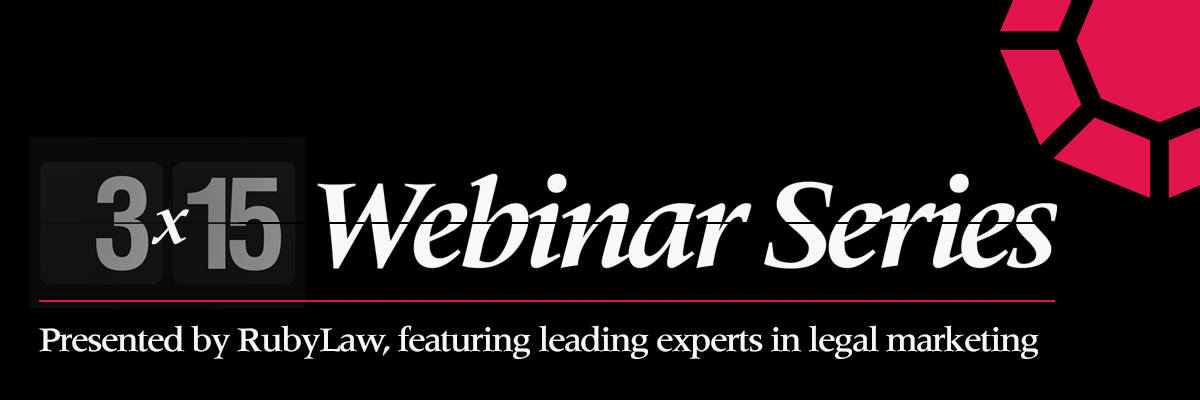Session 1: Managing legal web properties during a crisis
How would you evaluate your firm’s response to the COVID-19 crisis? What impact has it had on your website’s traffic and resulting visitor engagement? Could you be better prepared the next time a crisis hits, and what role will your current tech stack play?
It may yet be early to answer some of these questions, but please join us as we kick-off the first session in our three-part webinar series. This program features Molly Porter of Seyfarth, and focuses on best practices, insights, and recommendations around managing web properties during a crisis.
—Click here to register for Session #3, Launching the 2020 Legal Marketing Technology Stack
Transcription
Alexander Kotler (00:03): Greetings, and thank you for tuning into the first session of the RubyLaw 3-by-15 Webinar Series, Managing legal web properties during a crisis
The RubyLaw 3-by-15 Webinar Series is a three-part, quick-bite virtual program featuring expert practitioners and key members of the RubyLaw team. Each rapid-fire session will be 15 minutes long, and will also be available for viewing afterward if you can’t participate in the entirety of the session—or if you’d like to share it with your colleagues afterward.
Alexander Kotler (00:35): Today’s session features Molly Porter, Director of Marketing at Seyfarth, a pioneering Am Law 100 law firm and RubyLaw client. Seyfarth was recently ranked #1 by the Living Group in its publication of the Living Ratings: up from number 70 last year. Molly’s mandate is to drive marketplace awareness with stand-out messaging and content that inspires measurable action; her capacity for driving results will be evident today.
Alexander Kotler (01:04): Our focus in this session is on managing legal web properties during a crisis. Unfortunately, we find ourselves in one, so the topic is highly relevant to all of us.
Alexander Kotler (01:17): Before we start today’s session a brief word about our upcoming two sessions, Assessing the impact of COVID-19 on legal marketing websites and Launching the 2020 Legal Marketing Technology Stack. If you haven’t registered for these sessions, please do; we’ll be providing a link.
Alexander Kotler (01:33): Finally, if you’d like to ask any questions, please submit them via the Q&A module in Zoom. We’ll respond to as many as we can in our session recap, after the webinar ends.
Alexander Kotler (01:43): Without further ado, let’s dive into today’s session, Managing legal web properties during a crisis.
Alexander Kotler (01:51): During crisis situations, we’re often faced with two scenarios.
The first is to do nothing. To wait. To let an emergency happen, and then to sort out the pieces, often scrambling to organize a distributed team.
The second, and obviously ideal scenario, is to develop a plan, to identify needs and requirements and contingencies, and to have a system in place when emergencies happen. In theory, this will save time, potentially lives, and ensure a more cohesive, organized response.
Sometimes it’s obvious from the outside how prepared your organization is; other times, it’s not.
Alexander Kotler (02:30): Before looking at legal, a few examples from out-of-category. Google launched an information portal which features tips on staying healthy, provides links to official resources and fundraising efforts, shows the latest statistics, and more.
Alexander Kotler (02:48): CVS Health created its own resource center, which includes details on how it’s responding to customers’ needs, shifts in the global pharmaceutical supply chain, and the approach it’s taking in support of its employees.
Alexander Kotler (03:04): Management consultancy BCG is positioning itself as an advisor to global companies and public-sector organizations around managing the impact of the coronavirus, developing forecasts on the pandemic’s effect on the competitive environment, and how to assist its clients in developing a response. Its website has a bounty of related content to support these efforts.
Alexander Kotler (03:28): Now, let’s pivot to legal, and Jaron will highlight how some firms have responded and bring Molly and Seyfarth into the conversation.
Jaron Rubenstein (03:38): Thank you, Alex. At this stage most firms have created resource centers. In the immediate aftermath, there was obviously a flurry to do so we helped more than a dozen of our clients launch these. And they all took sort of different paths. So some created entry page notifications. Akerman is one example of that. Really focusing all of their visitors to the home page on this new resource center that they created that's content focused.
Jaron Rubenstein (04:04): Akin Gump is another. They actually weave the messaging into their branding on the home page. And clicking through to their resource center drives you to really more of a blog format. So the format of how these communications were developed and delivered have varied from firm to firm of course. They leveraged a blog format for their content.
Jaron Rubenstein (04:25): BCLP - Bryan Cave Leighton Paisner there, did a couple of things on their end. They created an omnipresent static notice, a banner across the site, across the home page, ensuring that visitors can't miss their messaging. And they directed visitors to either a client task force that they developed for COVID-19 response or more of a resource center of content. They used a topic which was the ability to associate content with attorneys, with professionals and other information in one central location.
Jaron Rubenstein (05:02): Now for Seyfarth. The firm's marketing leadership created a robust resource center as well as a look into the post pandemic period, which we'll look at in a short bit. Molly, thank you so much for joining us today.
Molly Porter (05:15): Thank you.
Jaron Rubenstein (05:15): Tell us a little bit about what you did and, and how you made it happen.
Molly Porter (05:20): Yeah. So, you know, the crisis around Coronavirus really started coming onto our radar probably last December. And our attorney expert started writing about it, I would say, in January. At that time, I think a lot of us, personally, I wasn't taking it all that seriously. But my firm was already taking it seriously just from a protection of our people, health and safety, and also tracking the crisis and doing internal communications. So we already had a crisis team in place that had helped us through, Katrina, I'm sorry, was that, that wasn't the most recent hurricane in Houston. The Hurricane in Houston. The California wild fires. So our firm was already looking at Coronavirus from a firm health and safety point of view.
Molly Porter (06:18): But starting in January, that's when we really started to think about it from our clients' point of view and what they needed to know. So really on the front lines was our workplace health and safety practice. They started doing alerts and blog posts on it. Then in March when it became obvious that things were gonna be very serious here in the United States, that's when more and more of our attorneys started creating content around this. And you're seeing the public resources. That was one of the first things that we put together on this resource center.
Molly Porter (06:51): So we started similar to Bryan Cave in that we had a trend on our site that aggregated sort of dynamically all of our Coronavirus related content. But starting around mid March, it became very obvious that that wasn't going to be sufficient. That there was a volume and a frequency of content that we were publishing like we had never seen before. So that's when I started thinking about our new website.
Molly Porter (07:18): So, one of the things that we did when we put together our new website, was we had a very flexible template as part of the design. If you go to our website, one of our main navigation areas on the website is called delivery. And that is a template that we created that was flexible enough that we could do a number of interesting things with it using these accordions, using feature panels, using ... I'm gonna wait for this to go down again. Using different design elements to make it more interesting to look at and to allow us to organize content.
Molly Porter (08:00): We had used this template also to produce our annual review, which we released in January. So, I had worked with it extensively. I knew it was quite flexible.
Molly Porter (08:10): Meanwhile on the other end of things, our team was really starting to kick into overdrive when it came to publishing content. And as we progressed through March, we were again, like I said, seeing a volume of content that we had not actually seen from a sort of crisis point of view, since Trump was elected in 2016. And that was a similar kind of response from our attorneys that they wanted to counsel our clients on what was going to change under a Trump administration. And one of the most, sort of fast moving of those areas was immigration.
Molly Porter (08:55): So, at that time, we had set up kind of a loose response protocol for when we need to do a large volume of client alerts on a very responsive timeline. So we returned to that. Like pretty soon in mid March, it became obvious that we would need to return to that protocol. And in this protocol, we have a number of people who are able to go into the website and publish alerts. And from there, we aggregate them on the website.
Molly Porter (09:32): Now, because we just launched a new brand, we were very, very fortunate in that we had stood up a lot of other processes and protocols for keeping things consistent. So we had new brand standards, we had a style guide, everyone had been trained. So we had a lot of that in process. The one thing that we did do pretty quickly was we switched from doing single targeted sends of emails to our clients, to a single daily digest on the Coronavirus.
Molly Porter (10:09): So when we launched this resource center that you're seeing now, we had 18 total legal updates and blog posts that we had done as a firm. Today we have over 300 total. And because we had this wonderful, flexible format, we could grow and evolve the resource center as the volume of content changed. So we started with 18. Now we've got over 300. We now have sections for individual practices, we have sections for industries, we have sections for our webinars as well. We added new material or new sections for the CARES Act when it was passed. And as well, we pivoted the branding on the whole thing to what you're seeing now which is the return to business.
Molly Porter (10:56): Just some interesting stats that I wanted to share with you. We now have over 300, legal updates which includes webinars. Our resource center itself has generated closing in on 50,000 unique visits. It's really become a destination for media as well. We've got, our media have been through the roof as well, as a result of the way that we've made it easy for reporters to find the information. We've had over 10,000 webinar visitors, webinar attendees, since the crisis started. We did launch a webinar series as well.
Molly Porter(11:40): Let's see, what else can I add to that?
Jaron Rubenstein (11:45): Amazing!
Molly Porter (11:45): ... I think that's it for the stats. So, I think what you're seeing now is, we just recently this last week, pivoted to a newer focus on the Coronavirus as states and counties and cities are starting to reopen or relax their shelter in place orders. Our clients have questions; they need information from us. So we launched a return to business checklist yesterday. And we have rebranded our resource center to be more focused around this idea of beyond COVID-19.
Molly Porter (12:23): Oh my gosh! I think I've gone over our 15 minutes. I'm really sorry. (laughs) Um-
Jaron Rubenstein (12:28):No, that's actually, I mean, that-
Molly Porter (12:28): ... but
Jaron Rubenstein (12:28): Go ahead.
Molly Porter (12:28): Go ahead, Jaron.
Jaron Rubenstein (12:34): No that, I think that covered everything, you know, in terms of like how you were able to mobilize your team so quickly to be able to get this information, to loop in, as you said, I mean, having a process in place already to manage this tons of updates and, you know, I think everyone's dream is always to have the attorneys so eager to contribute thought leadership like this. And so to be able to do that and have a process for how to manage that, and then getting it onto the site so effectively and efficiently is key. So it, I mean, it's amazing. And the metrics show that engine worked amazingly well. So kudos to you, Molly, and your team for making that happen.
Jaron Rubenstein (13:14): We do have a couple minutes left. I wanted to talk about, just to sort of recap the best practices for crisis response in legal, from what we heard from Molly, and our thinking. As we look into the future, you know, both generally and in the context of legal, we wanna ensure ... Or in order to ensure that you're prepared to deliver accurate information to the right stakeholders via the most appropriate channels, in the swiftest means possible, we wanna think about a few kinds of key points.
Jaron Rubenstein (13:40): So, generally speaking, you know, those are, what we just talked about, that process and how to serve information to those key stakeholders and making it available and possible, and then removing those bottlenecks, which is sounds like you had in place already to getting the information out there, was very effective and efficient. When it comes to legal marketing, Molly, maybe you wanna share a couple of the things that worked really well for you, specifically.
Molly Porter (14:06): Yeah. I think it's really important to have, or to have someone at the helm who understands the content as well as the technology, and vice versa. There is not any, in this fast moving realm, you can't really have a separation between an understanding of the content and how it gets published onto the website or what it looks like on the website. Because that's where all of the language and the user experience comes from. So it's very important for those to work together. Equally important is, you have to be able to leverage a scalable technology system.
Molly Porter(14:40): And if you do have a web redesign in your near future, to have a template that you can easily drag and drop and add new modules to a single page, I think is really an important aspect of being able to quickly stand something up like this without involving technologists or even ... II didn't even have to go back to you guys to have you add anything to the website. It was all already there.
Molly Porter (15:07): And then, obviously, you have to be able to keep your fingers on the pulse of what's going on in the world, act quickly, and really make it beautiful. I'm actually really jealous of that Akerman home page image because that was really beautiful.
Jaron Rubenstein (15:21): (laughs)
Molly Porter (15:21): Um-
Jaron Rubenstein (15:22): Awesome.
Molly Porter (15:22): ... so,I think that's it.
Jaron Rubenstein (15:25): Fantastic. Thank you. Back to you Alex.
Alexander Kotler (15:29): With that I wanna thank you, Molly. Thank you so much for participating in today's session. As well as to you, Jaron. And thank you to our audience. We'll be following up by email to provide a link so you can watch this session again. And please be sure to register for our next installations on May 14th and May 28th by the link at the top right. We'll see you next time for assessing the impact of COVID-19 on legal marketing websites with Ann Kalodis of Kramer Levin. Thank you so much.



